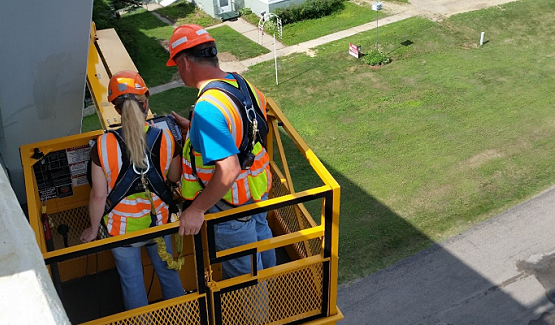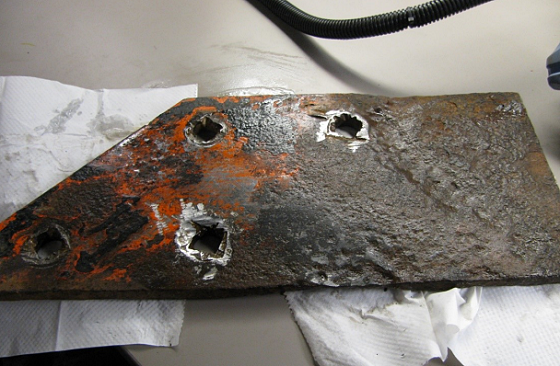The Minnesota Department of Transportation (MnDOT) (Saint Paul, Minnesota, USA) says the use of phased array ultrasonic testing (PAUT) with three-dimensional (3-D) scanning technology more accurately detects and measures corrosion on steel bridges than traditional methods.
According to MnDOT officials,1 more accurate data will enable its engineers to correctly identify bridge conditions, better calculate safe load capacity, and make superior maintenance recommendations.
“The phased array ultrasonic testing system can acquire thousands more data points than can traditional methods in the same amount of time, which makes PAUT technology very useful,” says William Lee Nelson, an MnDOT bridge engineering specialist.

Need for a New System
Transportation department officials explain that corrosion on steel bridges in their state typically results from exposure to environmental elements and deicing chemicals. These factors can lead to a loss of steel thickness, as well as subsequent functional and structural issues.
As such, regular inspections to detect and monitor fatigue cracking and any other structural damages are critical to extending the performance of the state’s bridges and ensuring traveler safety, the department explains. While MnDOT says it is committed to improving its infrastructure, it notes that rising costs for bridge inspections and maintenance have prompted it to seek out new methods for performing inspections.
According to the department, bridge inspectors have used conventional ultrasonic devices and hand measuring techniques to evaluate corrosion for many years. However, they caution that it is not always possible to obtain complete and accurate data using those methods.
“Without quality data, bridge engineers may make recommendations that can lead to unnecessary and expensive repairs,” MnDOT explains.
Results from the Study
To test the proposed system, MnDOT trained its bridge inspectors on the use of the OmniScan SX ultrasonic phased array flaw detector from Olympus (Waltham, Massachusetts, USA).
With up to 256 sound-wave emitters, the PAUT devices can focus at multiple locations and provide better defect detection than single-beam devices. With transducers and software, they can also be used for crack detection and weld inspection.
The state’s bridge inspectors used the new device to obtain corrosion mapping data for four steel structures in the state: the Sorlie Bridge in Polk County, Minnesota, USA; the Baudette Bridge in Baudette, Minnesota, USA; a high mast light in Duluth, Minnesota, USA; and a test specimen from the Silverdale Bridge in Grant, Minnesota, USA. The project team then compared the PAUT system data with data obtained from traditional single-beam ultrasonic methods and other field measuring techniques.

The first two bridges were chosen based on each having fracture critical characteristics, while the mast light was selected due to its known corrosion issues near the base. The mast light’s inclusion allowed inspectors to evaluate PAUT’s effectiveness on ancillary structures. Finally, the test specimen was taken from the iron Silverdale Bridge to evaluate the system’s potential for nondestructive testing (NDT) on samples in a laboratory environment.
According to MnDOT, the system provided superior results. Benefits included accurately determining the thickness and section of structural steel members, enabling engineers to make better recommendations on load capacity; establishing baseline measurements to better predict maintenance costs; providing high-quality data allowing engineers to make better repair and maintenance recommendations; and collecting inspection data more quickly, resulting in time and cost savings for bridge inspectors in the field.

Meanwhile, the NDT sample showed promise in the evaluation of rough and irregular surfaces, which the department says can be difficult to accurately measure in the field.
Future Inspection Plans
Minnesota has ~13,000 bridges in total, and MnDOT says it plans to begin deploying the system to conduct corrosion inspections on other steel bridges and ancillary structures throughout the state.
The department also plans to revise the NDT content in its inspection manual, targeting bridge inspection units, bridge engineers, and bridge owners.
“Traditional field measuring methods often underestimate the remaining thickness of structural
members due to the limitations in the amount of data that can be collected,” MnDOT writes in its final report2 on the study. “The lack of data points leads to conservative estimates of remaining thickness. Without accurate results, a structural member’s capacity may be underestimated, and result in decisions to repair or replace that may be unnecessary and expensive. PAUT can provide data that is orders of magnitude larger, leading to more accurate results.”
Source: MnDOT, dot.state.mn.us.
References
1 “Ultrasonic Testing Method Improves Corrosion Detection on Steel Bridges,” Crossroads: A Minnesota Transportation Research Blog, July 23, 2018, https://mntransportationresearch.org/2018/07/23/phased-array-ultrasonic-testing-produces-enhanced-bridge-corrosion-data/ (October 17, 2018).
2 B. Lovelace, “Phased Array Ultrasonic Steel Corrosion Mapping for Bridges and Ancillary Structures,” Minnesota Department of Transportation Research Project Final Report 2017-33, August 2017, http://www.dot.state.mn.us/research/reports/2017/201733.pdf (October 17, 2018).